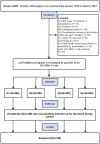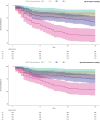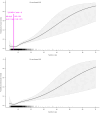Independent and combined associations of high-density lipoprotein cholesterol-modified triglyceride-glucose index with all-cause and cardiovascular mortality in patients with acute decompensated heart failure
- PMID: 40801032
- PMCID: PMC12339345
- DOI: 10.3389/fendo.2025.1629066
Independent and combined associations of high-density lipoprotein cholesterol-modified triglyceride-glucose index with all-cause and cardiovascular mortality in patients with acute decompensated heart failure
Abstract
Introduction: Dysregulation of glucolipid metabolism is a central pathological mechanism underlying acute decompensated heart failure (ADHF) and significantly impacts its poor prognosis. This study aims to investigate the association between the high-density lipoprotein cholesterol-modified triglyceride-glucose index (defined as TyG/HDL-C) and their interaction with 30-day mortality in patients with ADHF.
Methods: From 2018 to 2024, 2,329 ADHF patients enrolled in the Jiangxi-ADHF II cohort were included. Multivariable Cox regression models were utilized to evaluate the association between TyG/HDL-C ratio and 30-day all-cause/cardiovascular mortality risk. A 3-dimensional interaction model was employed to examine the dose-response relationships of TyG and HDL-C with mortality risk. Additionally, exploratory mediation models were constructed to investigate potential mediating effects of inflammation, oxidative stress, and nutritional metabolism in the association between TyG/HDL-C ratio and mortality risk.
Results: At 30-day follow-up, 150 deaths occurred, 115 of which were cardiovascular. Multivariable Cox regression showed that each standard deviation increase in TyG/HDL-C ratio increased 30-day all-cause mortality by 24% and cardiovascular mortality by 20%. These findings demonstrated robustness across sensitivity analyses conducted from four dimensions: model adjustment, causal timing, population heterogeneity, and data integrity. Notably, the subsequent 3-dimensional interaction model analysis revealed a complex U-shaped association - resembling a concave surface of a radio telescope - between the combined effects of TyG index and HDL-C on mortality risk. Specifically, both excessively low and high combinations of TyG index and HDL-C were associated with elevated 30-day mortality risk in ADHF patients, while the lowest mortality risk interval occurred when the TyG index remained within 7.5-9.0 and HDL-C levels were maintained at 1.0-1.5 mmol/L. Mediation analysis further suggested that inflammatory and nutritional pathways might serve as significant mediators of mortality risk related to TyG/HDL-C ratio.
Discussion: The TyG/HDL-C ratio emerged as an independent predictor of short-term all-cause and cardiovascular mortality in ADHF patients, demonstrating significant enhancement in predictive performance for these outcomes. Most notably, the concave-shaped interaction pattern revealed by 3-dimensional interaction analysis provided an evidence-based threshold framework for metabolic management in ADHF patients, which may hold substantial clinical significance for reducing future mortality risks in this population.
Keywords: TyG/HDL-C ratio; acute decompensated heart failure; all-cause mortality; cardiovascular mortality; cardiovascular mortality acute decompensated heart failure; insulin resistance.
Copyright © 2025 He, Xie, Xie, Jian, Jiang, Lu, Zhang, Wang, Lu, Xiong, Wu, Sheng, Lai, Wang and Zou.
Conflict of interest statement
The authors declare that the research was conducted in the absence of any commercial or financial relationships that could be construed as a potential conflict of interest.
Figures





Similar articles
-
Prescription of Controlled Substances: Benefits and Risks.2025 Jul 6. In: StatPearls [Internet]. Treasure Island (FL): StatPearls Publishing; 2025 Jan–. 2025 Jul 6. In: StatPearls [Internet]. Treasure Island (FL): StatPearls Publishing; 2025 Jan–. PMID: 30726003 Free Books & Documents.
-
[Association Between Surrogate Markers of Insulin Resistance and Incident Cardiovascular Disease in a Population With Stages 0-3 Cardiovascular-Kidney-Metabolic Syndrome: A Prospective Cohort Study].Sichuan Da Xue Xue Bao Yi Xue Ban. 2025 Mar 20;56(2):495-505. doi: 10.12182/20250360503. Sichuan Da Xue Xue Bao Yi Xue Ban. 2025. PMID: 40599269 Free PMC article. Chinese.
-
Association between insulin resistance indices and outcomes in patients with heart failure with preserved ejection fraction.Cardiovasc Diabetol. 2025 Jan 22;24(1):32. doi: 10.1186/s12933-025-02595-x. Cardiovasc Diabetol. 2025. PMID: 39844150 Free PMC article.
-
Dietary Approaches to Stop Hypertension (DASH) for the primary and secondary prevention of cardiovascular diseases.Cochrane Database Syst Rev. 2025 May 6;5(5):CD013729. doi: 10.1002/14651858.CD013729.pub2. Cochrane Database Syst Rev. 2025. PMID: 40326569 Review.
-
Does diabetes status modify the association between the triglyceride-glucose index and major adverse cardiovascular events in patients with coronary heart disease? A systematic review and meta-analysis of longitudinal cohort studies.Cardiovasc Diabetol. 2025 Aug 4;24(1):317. doi: 10.1186/s12933-025-02890-7. Cardiovasc Diabetol. 2025. PMID: 40760488 Free PMC article.
References
-
- Bozkurt B, Coats AJS, Tsutsui H, Abdelhamid CM, Adamopoulos S, Albert N, et al. Universal definition and classification of heart failure: a report of the Heart Failure Society of America, Heart Failure Association of the European Society of Cardiology, Japanese Heart Failure Society and Writing Committee of the Universal Definition of Heart Failure: Endorsed by the Canadian Heart Failure Society, Heart Failure Association of India, Cardiac Society of Australia and New Zealand, and Chinese Heart Failure Association. Eur J Heart Fail. (2021) 23:352–80. doi: 10.1002/ejhf.2115, PMID: - DOI - PubMed
-
- Metra M, Tomasoni D, Adamo M, Bayes-Genis A, Filippatos G, Abdelhamid M, et al. Worsening of chronic heart failure: definition, epidemiology, management and prevention. A clinical consensus statement by the Heart Failure Association of the European Society of Cardiology. Eur J Heart Fail. (2023) 25:776–91. doi: 10.1002/ejhf.2874, PMID: - DOI - PubMed
-
- Bernheim SM, Grady JN, Lin Z, Wang Y, Wang Y, Savage SV, et al. National patterns of risk-standardized mortality and readmission for acute myocardial infarction and heart failure. Update on publicly reported outcomes measures based on the 2010 release. Circ Cardiovasc Qual Outcomes. (2010) 3:459–67. doi: 10.1161/CIRCOUTCOMES.110.957613, PMID: - DOI - PMC - PubMed
LinkOut - more resources
Full Text Sources

